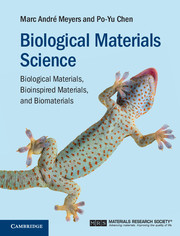Part II - Biological materials
Published online by Cambridge University Press: 05 August 2014
Summary
Biological materials
Nature has evolved a palette of biological materials to address different structural requirements such as:
hardness,
toughness,
stretchability,
light weight.
The intricate and ingenious hierarchical structure is responsible for the outstanding performance. Toughness is conferred by the presence of controlled interfacial features, buckling resistance can be achieved by filling a slender column with a lightweight foam, and armor protection is accomplished by small dermal plates with unique attachment arrangements, resulting in controlled and prescribed flexibility. In Chapters 6–10 we present and interpret selected examples of biological materials. In addition to the structural requirements, there are also functional requirements such as adhesion and optical properties.
The number of elements and compounds that can be synthesized at ambient temperature and in aqueous environments is limited, and therefore the architecture of the structure is of utmost importance.
We introduce the different classes of biological materials in these chapters, following the Wegst–Ashby classification. These were defined in Chapter 2 (Fig. 2.11) as:
biominerals (Chapters 6 and 7),
biopolymers (Chapter 8),
bioelastomers (Chapter 9),
biocellular materials (foams) (Chapter 10).
- Type
- Chapter
- Information
- Biological Materials ScienceBiological Materials, Bioinspired Materials, and Biomaterials, pp. 155 - 156Publisher: Cambridge University PressPrint publication year: 2014



